Implementation and validation of an intelligent auto-verification system in a coagulation testing automatic line
IF 2.1
3区 医学
Q2 MEDICAL LABORATORY TECHNOLOGY
引用次数: 0
Abstract
Objective
To evaluate the implementation and optimization of a fully automated coagulation testing system integrating dual-coagulation-autoline and auto-verification protocols in a high-throughput laboratory, aiming to enhance operational efficiency, standardization, and clinical utility.
Methods
A dual-coagulation-autoline system was deployed, each line equipped with four automated coagulation analyzers. Pre-implementation quality assessments evaluated centrifuge performance, open/closed-cap sampling, robotic arm effects, and sample stability. Auto-verification rules were optimized using several guidelines and validated with 18,373 samples. Key metrics included pass rate, sensitivity, specificity, and turnaround time (TAT).
Results
All centrifuged specimens met platelet-poor plasma criteria (platelet count <10 × 109/L). No significant differences (P > 0.05) were observed between open/closed-cap sampling, robotic arm handling, or room-temperature storage (≤4h). The dual-coagulation-autoline system reduced outpatient and inpatient TAT by 16.78 % (from 49.77 min to 41.42 min) and 33.06 % (from 110.3 min to 73.83 min), respectively, while sample volume increased by 7.9 % (from 74,902 to 80,869). Optimized auto-verification rules achieved a 62.48 % pass rate (11,479/18,373), 100 % sensitivity, 93.50 % specificity, and 0 % false negatives, outperforming initial benchmarks. Auto-verification reduced outpatient and inpatient TAT by 8.29 % (from 41.42 min to 38.25 min) and 16.21 % (from 73.83 min to 63.53 min), respectively, while sample volume increased by 2.8 % (from 80,869 to 83,126).
Discussion
The integration of dual-coagulation-autoline and refined auto-verification significantly improved TAT, reduced manual errors, and standardized workflows in a high-volume setting. Personalized system optimization, including dynamic testing allocation and real-time tracking, enhanced clinical efficiency. The validated auto-verification framework demonstrated robust generalizability for large-scale laboratories. The successful application and personalized setting of our laboratory can provide experience for other laboratories.
凝血检测自动线智能自动验证系统的实现与验证。
目的:评价高通量实验室全自动凝血检测系统的实施和优化,以提高操作效率、标准化和临床实用性。方法:采用双混凝-自动线系统,每条线配备4台自动凝血分析仪。实施前质量评估评估了离心机性能、开/闭帽取样、机械臂效果和样品稳定性。自动验证规则使用若干指导原则进行了优化,并使用18,373个样本进行了验证。关键指标包括通过率、敏感性、特异性和周转时间(TAT)。结果:所有离心标本均符合血小板差血浆标准(血小板计数9/L)。开盖/闭盖取样、机械臂搬运或室温储存(≤4h)之间无显著差异(P > 0.05)。双凝-自动线系统使门诊和住院患者TAT分别降低了16.78 %(从49.77 min降至41.42 min)和33.06 %(从110.3 min降至73.83 min),而样本量增加了7.9 %(从74,902降至80,869)。优化后的自动验证规则通过率为62.48 %(11,479/18,373),灵敏度为100 %,特异性为93.50 %,假阴性为0 %,优于初始基准。自动验证使门诊和住院患者TAT分别减少了8.29 %(从41.42 min减少到38.25 min)和16.21 %(从73.83 min减少到63.53 min),而样本量增加了2.8 %(从80,869增加到83,126)。讨论:双混凝自动检测和精细自动验证的集成显著提高了TAT,减少了人工错误,并在大批量设置中标准化了工作流程。个性化的系统优化,包括动态测试分配和实时跟踪,提高了临床效率。经过验证的自动验证框架在大型实验室中具有强大的通用性。本实验室的成功应用和个性化设置可为其他实验室提供经验。
本文章由计算机程序翻译,如有差异,请以英文原文为准。
求助全文
约1分钟内获得全文
求助全文
来源期刊

Clinical biochemistry
医学-医学实验技术
CiteScore
5.10
自引率
0.00%
发文量
151
审稿时长
25 days
期刊介绍:
Clinical Biochemistry publishes articles relating to clinical chemistry, molecular biology and genetics, therapeutic drug monitoring and toxicology, laboratory immunology and laboratory medicine in general, with the focus on analytical and clinical investigation of laboratory tests in humans used for diagnosis, prognosis, treatment and therapy, and monitoring of disease.
 求助内容:
求助内容: 应助结果提醒方式:
应助结果提醒方式:


